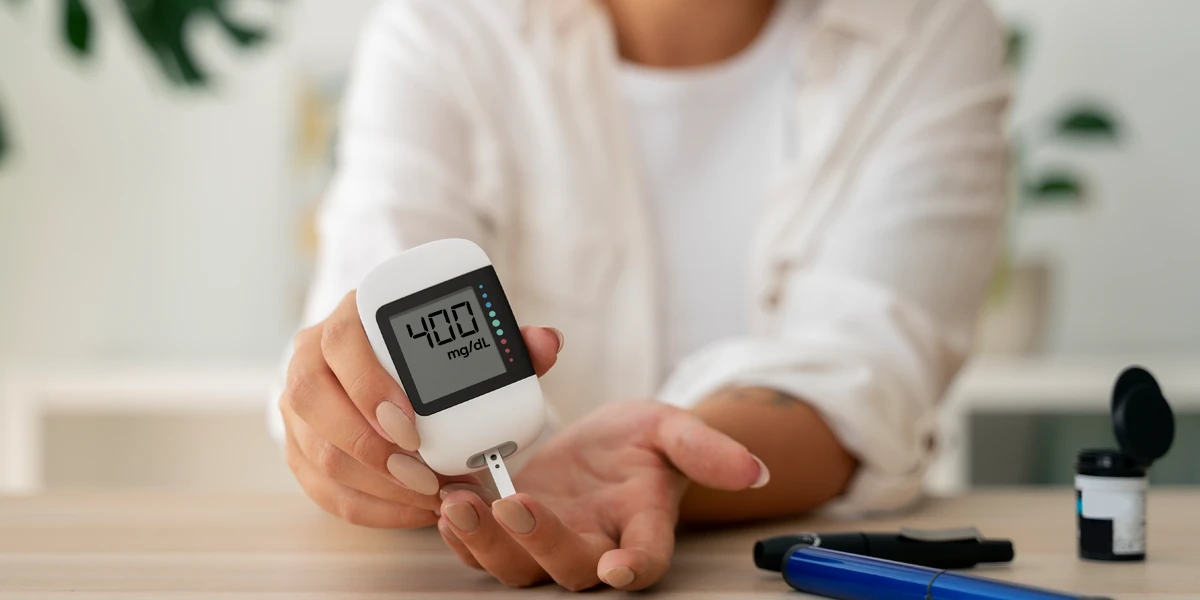What to Do When Your Blood Sugar Spikes Above 400

Situation 1: Amita has an active lifestyle and used to go for routine check-ups every 3 months, with all health parameters normal (like blood pressure, cholesterol, and heart rate).
During one check-up, she discovered her blood sugar reading was 400 mg/dL (normal range: 70-140 mg/dL). She was shocked and clueless about what to do and how it had reached 400 mg/dL. Did she have diabetes?
Situation 2: Ramesh has diabetes and has kept it under control, taking his medication as prescribed and maintaining a healthy lifestyle.
One day, while checking his blood sugar at home, he found that his blood sugar level was over 400 mg/dL. Despite all his efforts, he was taken aback and puzzled at how it had reached 400 mg/dL.
Have you or someone in your family experienced a situation similar to the ones described above, discovering your blood sugar at 400 mg/dL or around this value?
If so, this blog is for you. Here, we will help you understand the causes and symptoms you might experience when your blood sugar levels are high, around 300-400 mg/dL, and provide expert tips on managing such alarming spikes.
Did you know that high blood sugar can occur whether you have diabetes or not, and the causes can vary?
What are the Possible Causes of High Blood Sugar Levels
1. For People With Diabetes
High blood sugar can happen due to:
- Skipping or not taking diabetes medication or insulin regularly.
- Eating too many high-carb meals with little fiber or protein.
- Not exercising enough.
- Being stressed or ill often.
- Not getting enough sleep regularly.
These factors can spike your blood sugar levels.
Here, you might wonder why Ramesh’s blood sugar spiked despite taking his medications and maintaining a healthy lifestyle.
Sometimes, blood sugar levels can still reach 300-400 mg/dL or above, indicating that adjustments might be needed in your diabetes medications or insulin.
It’s important to consult your doctor immediately in such cases.
2. For People Without Diabetes OR Not aware that they have diabetes
In people without diabetes or those unaware they have it, high blood sugar can be caused by:
- Family history of diabetes (type 2 diabetes)
- Autoimmune cause (type 1 diabetes) and other types of diabetes
- Obesity
- High carb diet
- Sedentary Lifestyle
- Lack of physical activity or exercise
Now, let’s talk about the symptoms that people with high blood sugar spikes can experience.
Symptom You May Experience When Your Blood Sugar Spikes Above 300-400 mg/dL
- Frequent Urination
- Extreme Thirst
- Feeling tired & exhausted
- Blurred Vision
- Nausea and Vomiting
- Rapid Breathing
Immediate Steps to Take When the Blood Sugar Level is Above 400 mg/dL
With a blood sugar spike above 400 mg/dL, it’s important to take the following actions immediately (not in any chronological order):
First and foremost, consult with your doctor as soon as possible and strictly follow the advice given by your doctor.
While seeking immediate medical advice is most important, here are some tips from our Diabetologist, Dr. Vidya, on what you can do if your blood sugar spikes to 300-400 mg/dL or above:
1. Drink Water
This helps flush out excess sugar through your urine. Avoid sugary drinks as they can raise your blood sugar levels even further.
2. Check for Ketones
Test for ketones in your urine. High levels of ketones can indicate ketoacidosis, a serious complication of diabetes that needs immediate treatment.
3. Avoid Exercise
When your blood sugar is this high, especially if ketones are present, physical activity can increase your blood sugar.
4. Go to a Lab
Get your blood sugar tested along with your other health parameters.
You now know what to do when your blood sugar levels are above 300-400 mg/dL, but it’s better to prevent such situations altogether.
To avoid these emergencies, our expert health coaches at Fitterfly advise our Diabetes Prime Program members to maintain an active lifestyle and provide specific guidance on how to achieve this. Here are some things you can do:
Add these to Your TO-DO list to Consistently Maintain Your Blood Sugar in a Healthy Range
1. Eat a Balanced Diet
If your plate has more carbs like more rice and more rotis and less vegetables, dal or salad, then it’s time to change it.
Focus on consuming a balanced diet that includes a variety of nutrient-rich foods such as vegetables (such as palak, lauki, gobhi, etc), fruits (like amrud, santre, etc), whole grains, lean proteins (like dal, paneer, etc), and healthy fats (such as nuts and seeds, eggs etc).
Avoid sugary and processed foods (like soft drinks, maida pizza, maida white sauce pasta, etc) that can spike your blood sugar.
2. Maintain a Healthy Lifestyle
We all love sitting or lying at our favorite spot with a gaming console or playing games on our mobiles as a way to relax.
However, these habits can lead to a sedentary lifestyle and then weight gain which might increase your risk of health issues like heart disease and diabetes.
Instead, consider balancing screen time with physical activities such as playing badminton, football, or any other sports you enjoy. You might even try walking or jogging – whatever you prefer.
3. Increase Fluid Intake
Of course, you know how important drinking enough water is. But in our busy schedules, we often forget to either drink enough water or track our intake.
One smart way to do this is by simply gifting yourself a 1 or 2-liter water bottle with markings (easily available in the market these days) and finishing it once or twice daily to ensure proper hydration.
4. Exercise Regularly
“I hate getting up in the morning to exercise”. Sounds like your mind voice? We get it. It can be super tough to get up in the morning and go exercising, but hold on.
No one said you need to exercise only in the morning! First, you can exercise anytime, anywhere that’s convenient for you, including your home.
Secondly, to make exercising fun, you can involve your partner or spouse, play fun, fast-paced music, take your pet for a walk with you, wear your baby while doing the rounds, or join fun exercise classes like Zumba, water yoga, etc.
We bet, you will then be saying “ I can’t wait for tomorrow for my exercise time”😃
5. Manage Stress
Who says only meditation and yoga can help reduce stress? Good news is
That there are countless other activities you can do to lower your stress levels, such as taking your dog for a walk, talking to a friend, creating mandala art, learning a new art form, or taking classes in dance, pottery, singing, or playing an instrument.
The point is, do ANYTHING that makes you feel relaxed and happy. That will really help you reduce your stress levels.
6. Get Enough Sleep
After a tiring day, many of us enjoy watching our favorite web series or movies curled up in our sofa or bed. But here’s the problem.
By doing so (on a daily basis), you are messing up your sleep quality and hours of sleep too. Try ditch the mobile screen atleast an hour before sleep time.
Studies have shown that getting good quality sleep for 7-8 hours every night can help regulate your blood sugar levels and overall health.
7. Monitor Your Blood Sugar Levels
Keeping a close eye on your blood sugar has two big benefits. First, it reassures you that your efforts to manage your blood sugar are working when you see normal levels.
Second, this success gives you a mental boost and encourages you to stick with the healthy changes you’ve made.
It’s also important to monitor your blood sugar regularly to catch any unusual changes early and get help if needed.
A simple tip is to keep a notebook to jot down your fasting, post-meal, and random blood sugar readings, helping you stay informed and on top of your health.
8. Regular Check-Ups and Follow-Up with the Doctor
Technology can be a helpful tool in managing your busy schedule. To avoid missing doctor appointments, consider setting a reminder on your phone or booking appointments well in advance to receive notifications directly from the hospital.
How We At Fitterfly Can Help You?
At Fitterfly, we have come across members who have had very high blood sugar levels. So, we understand that managing sudden blood sugar spikes, like those between 300-400 mg/dL can be worrying.
While it’s important to see your doctor right away in these situations, our main goal is to help you avoid these spikes in the first place.
With our Diabetes Prime Program, we do this by creating personalized plans tailored to your diet, fitness, sleep, and overall wellness, alongside regular blood sugar monitoring as part of our approach.
We keep a close eye on your health and quickly adjust your plan if we see any changes in your blood sugar levels.
When you join Fitterfly, apart from expert advice, you also get support from a dedicated WhatsApp community that understands what you’re going through.
We encourage you to contact us today at 08069450746 to know more about how our Diabetes Prime Program can benefit you or a loved one.
Reduced diabetes medications in 3 months


6.8%
Happy members
EMI
Guarantee
4.8/5
Diabetes Prime Program
This blog provides general information for educational and informational purposes only and shouldn't be seen as professional advice.
Frequently Asked Questions
Should I take insulin if my blood sugar is over 400 mg/dL?
If your blood sugar is over 400 mg/dL, it's important to consult with your doctor immediately. Your doctor will decide if you need insulin injection or it can be managed with the oral medicine.
How to get blood sugar down from 400 mg/dL?
If your blood sugar reaches 400 mg/dL, consult your doctor as soon as possible. Check for ketones in your urine, avoid exercise if ketones are present, eat low-carb meals, and monitor your levels regularly. Follow your doctor’s instructions closely.
Is a blood sugar level of 400 mg/dL dangerous?
Yes, a blood sugar level of 400 mg/dL is considered dangerously high and requires immediate medical attention. Such high levels can lead to serious complications, including diabetic ketoacidosis (DKA), especially in people with type 1 diabetes, or hyperosmolar hyperglycemic state (HHS) in people with type 2 diabetes. Both conditions are medical emergencies.
Should I go to the hospital if my blood sugar is over 300 or 400 mg/dL?
If your blood sugar is over 300 or 400 mg/dL, especially if you are experiencing symptoms like nausea, vomiting, rapid breathing, or confusion, you should go to the hospital immediately, and those without symptoms, needs to follow up with their doctor as it can lead to diabetes complications, if not controlled.



















